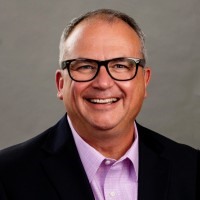To hear Rob Hanlon discuss what has made him successful as an executive is to understand the value of active listening. Hanlon learns how to best achieve both his IT organization’s goals, and how to unite his executive peers in their pursuit of strategic objectives, by listening to what his colleagues say matters to them. As most CIOs know, achieving such unity can be challenging if executives from different parts of an enterprise are working with a varied set of objectives.
Rob Hanlon studied computer science and started his career as a software developer and rose through the IT ranks. Along the way, he earned an MBA from Booth School of Business at the University of Chicago. He first became CIO in 2001 when he was appointed vice president and CIO at MeadWestvaco Consumer Packaging, a $1.2 billion global company. In 2007 he became senior vice president and CIO at TreeHouse Foods. He now works as CTO at startup CyberMoney Mobile Payments.
In this interview, Hanlon explains how intentional listening demonstrates empathy and creates human connection – and how it has set enabled him to build relationships, guide organizational transformations and – perhaps most importantly – created trust, which he sees as a foundation for all his work.
Mary K. Pratt: You describe yourself as a hands-on technology executive. Why do you view that “hands-on” part as important?
 Rob Hanlon: As CIO, it is easy to become disconnected from what is happening on the ground. But by being hands-on, I keep that connection to what is happening and I stay connected with the people doing the work. It allows me to do a deep dive into something or just hear what people have to say.
Rob Hanlon: As CIO, it is easy to become disconnected from what is happening on the ground. But by being hands-on, I keep that connection to what is happening and I stay connected with the people doing the work. It allows me to do a deep dive into something or just hear what people have to say.
There are other benefits, too. It shows the team that I care. They see that I am engaged. I also think it is important for my own professional integrity, so when I am in an executive meeting, I can say with certainty what is happening versus assuming I know what is going on.
Being hands-on means being interested in what people are doing and being inquisitive. So I walk around and ask really pointed questions. I talk to the folks doing the work. In that way, being hands-on is relationship-driven. It is connecting with people and building trust with them so they tell you what you need to hear and they understand that as a CIO I want to solve problems together.
How do you approach creating trust-based relationships?
I build trust-based relationships by having empathy, interest and understanding as well as hearing others’ angst. I get to know people. I listen. I do not go in and say a lot. I do not go in and try to impress. My motto is be interested; do not be interesting. Because if you are interested, that connection will happen.
I will give you an example. When I was at MeadWestvaco Consumer Packaging, the company was growing globally through acquisitions. But the general managers at those acquired companies remained focused on their own individual territories. We had to find a way to break through that.
So I spent time with each one of those managers in their business. I would walk through their plants and get to know people. I would ask questions such as “How does this work?” I never said, “Let me tell you how we do it.” I just listened, and it created a connection. They saw I was someone who cares and someone who was willing to hear them and understood what was important to them.
Some of those general managers had their own children – young professionals in their 20s – working in their businesses. And they actually sent their children from their businesses to work on my projects in the United States because they saw it as a learning experience but also because they trusted me.
You also talk about “uniting business stakeholders.” How do you achieve that unity?
Every company has a vision, a mission, a business strategy, which is typically three years, and the annual plan. All the C-level executives then have their three-year objectives and their annual plans.
But what happens a lot of times is that every executive is united on the strategy but their individual annual objectives may not be linked. In fact, sometimes one executive’s plan is mutually exclusive of the other leaders’ plans.
So I first aim to understand the business’ strategy and its annual plan and then each executive’s annual plans and what each executive needs to accomplish. I get that by listening to them. I ask: “What are your tactics?” and “What are you worried about?” This is where a trust-based relationship is important; they have to trust me to share that information.
Once I understand their goals and their hurdles, I am able to help, because I can start to see patterns. I can see connections and dependencies that they may not initially see.
For example, any single executive may not have enough capital or money to cover all his or her priorities, so as CIO I help the executives start to negotiate. I get them together to talk through all their top priorities. Then they, too, can see the dependencies between what others need and what they need and how if one executive gets a priority project done, it will help them, too. I have seen an executive in one area say that he would give up a portion of his capital to another executive for that reason.
That is when we get unity and we get alignment.
You said you are disciplined at meeting management. How so?
I schedule only a half-hour or an hour at the most. I stick to an agenda. And I understand how to redirect conversations. People are well-intentioned and passionate, and I do not want to squash that, but sometimes it is necessary to redirect conversations back to the main topics so the meeting is productive for everybody.
|
Related article: How Kristina Paschall Takes on Digital Strategy in Addition to IT Leadership |
Were you always a good listener or did you develop this skill?
People want to help. They think they know how to make a situation better and they want to share their thoughts before others have even finished saying what the problem is.
I had that problem, too. When I started at TreeHouse Foods, I would do that to the CEO, who would have to say, “Let me finish.” He said that to me three times once in a meeting. And I thought, “I have a problem.” It was then that I realized I must be quiet and let him speak.
You are now CTO of CyberMoney Mobile Payments. What are the challenges of making a shift to a startup CTO role?
The first challenge is that I have zero leverage; as a leader in a startup, I have nothing to horse-trade. But I am finding that people in the startup world really rely on connections, and it is amazing to see how many potential partners are out there. It is amazing to have people approach me saying, “Our two platforms can work together.”
That leads to another challenge: There are so many times the company could go down a path and it leads to nothing. So while I must be very adept at cultivating relationships, I also must know when it is not turning into a mutually beneficial business partnership.
The upside, though, is when something works, it is magic. It is so energizing when you advance the ball in a meaningful way – for example, gaining a new customer or creating a new capability. Those nuggets keep me going. This company is private-equity based, so I thought the big energy would be the financial payoff at the end. But that seems so far down the road now that I do not think about it. Right now I get my joy out of seeing progress made.
How did becoming a CTO change your career trajectory?
After agreeing to become CTO and board member at CyberMoney, I formed West Washington Partners, a business and technology consulting firm, in 2021 to take on additional advisory and fractional CIO work.
I see working at a tech startup as hugely additive to my portfolio of capabilities. I thought others would see it that way, too. But I have found that the move can confuse some people who wonder why I did not just move to a CIO position at a larger company. I did not anticipate that response at all, but I am still glad I took the role.

Written by Mary K. Pratt
Mary K. Pratt is an award-winning journalist who currently writes about enterprise IT and cybersecurity strategy and management topics. Her work has appeared in numerous publications, including CIO, CSO, Computerworld and The Wall Street Journal.



